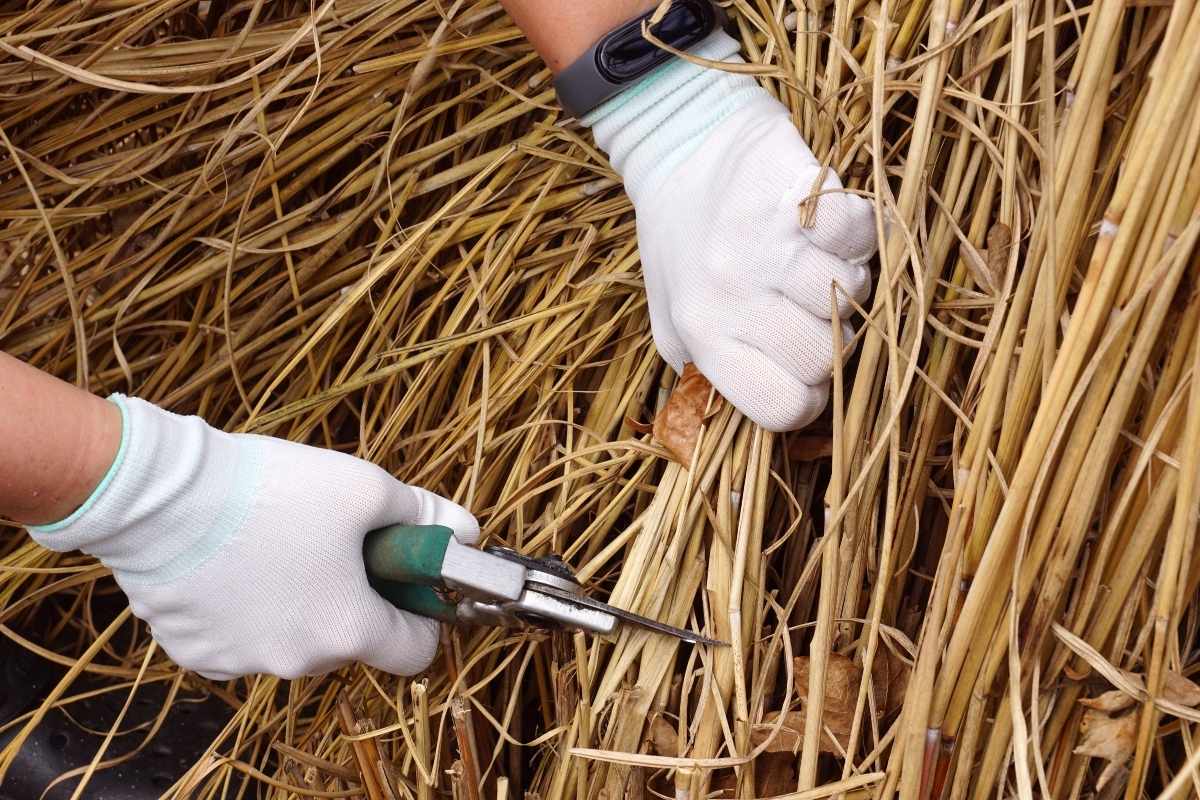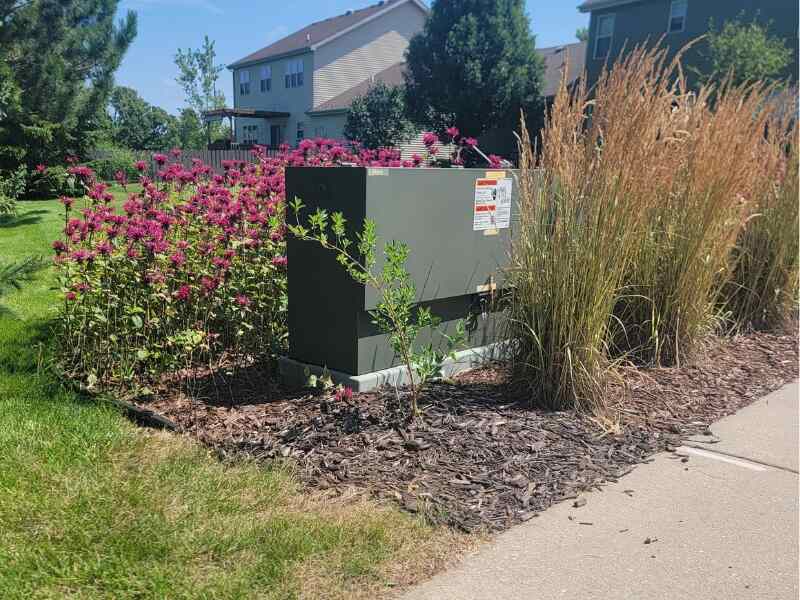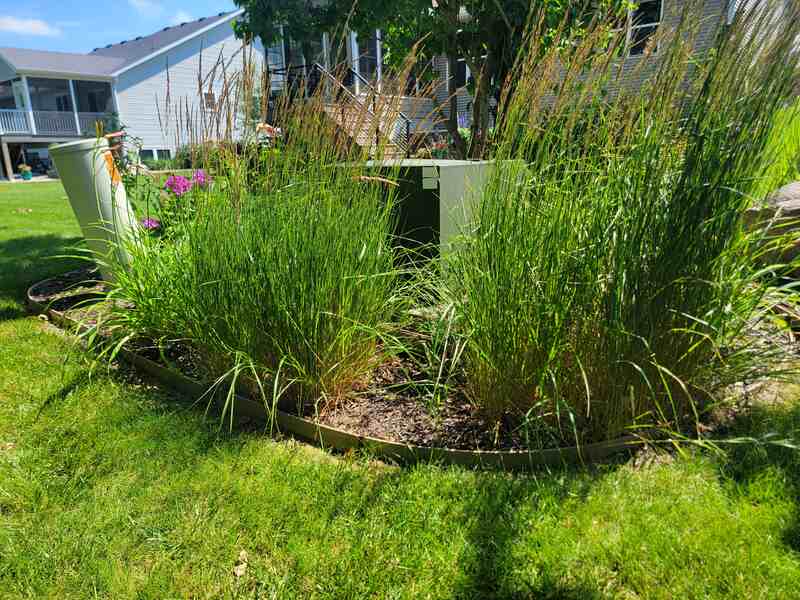
Cutting back ornamental grasses is a simple DIY task when you have the right tools and know-how. Just bundle the grass, then cut the stems using a hedge trimmer.
You’ll need to adjust your approach for large grasses and those planted in borders, groups, or tight spaces. Our article discusses all these details, so by the time you finish it, you’ll know exactly how to cut back each of your ornamental grasses.
What we cover in this piece about pruning ornamental grasses:
| Project Difficulty: Beginner to Intermediate Estimated Time to Complete: 10 to 30 minutes per plant, depending on size Project Cost: $85-$205 (including leather garden gloves, rope, pruning shears, and a hedge trimmer) |
Benefits of cutting back ornamental grasses: Flawless growth with clean, intense colors and a perfect tufted, upright, or arching shape, depending on the species. Pruning also reduces the risk of pests and diseases.
Tools You’ll Need
- Safety equipment: Garden gloves, goggles, and long sleeves and pants
- Bundling tools (if tying large grasses): Twine, bungee cords, or paper tape
- Cutting tools: Pruning shears, hedge shears and hedge trimmer
- Clean-up tools: Garden rake and wheelbarrow (or a tarp)
Use sharp, clean cutting tools to avoid spreading diseases. Cut with a hedge trimmer whose blade is at least 2 inches larger than your grass bundle’s width. This way, it cuts evenly and goes through the entire bundle at once.
Note: If you’re not handy with tools, hire a professional landscaper to prune your ornamental grasses.
Step-by-Step Guide to Trimming Ornamental Grasses

Two things you need to know before starting:
- When to cut: The best time to cut back ornamental grasses is in spring when plants prepare to green up, but warm-season grasses can also be pruned during their fall and winter dormancy.
- An exception: Cut back evergreen grasses only if they show significant browning. Otherwise, trim the dry flower stalks and rake dead stems by combing the clump with your gloved hand.
Step 1: Prepare the Area
- Remove obstacles around the grass bundles (e.g., stones, spiny weeds, outdoor furniture).
- Bring a wheelbarrow or a tarp nearby to collect the cuttings.
- Place the tools close by.
- Keep children and pets away while working.
Step 2: Bundle the Grass
Tying up large grasses keeps the stalks together, making cutting and cleanup much easier.
- Wrap the twine around the grass bundle (brightly colored twine is easier to see).
- Stretch it tightly, and tie it with two knots.
- When using tape, press the layers firmly to make sure they stick.
| You’ll cut the grass BELOW the twine, so leave enough room. Wrapping the bundle 12 to 18 inches above the ground is a good fit for most grasses. |
Pro Tip: If the grass is in a tight area — against the house, a fence, or a shed — tie the rope to a broom or a pole and slide it around the plant’s back and back to you.
Step 3: Make the Cut
Time to cut! Put on thick gloves (grasses have sharp blades that can cut your skin) and goggles, and get to work. If you use hedge shears, tackle just a few stems at once — thick bundles can strain your hand.
- Aim to keep the bundle intact while trimming.
- Don’t cut too close to the twine. You risk the stalks getting loose and spreading all over the yard.
Here’s a video from the University of Illinois showing how to use a bungee cord and hedge shears to prune switch grass, a tall ornamental grass great for privacy screens.
How low should you cut the ornamental grasses in your yard? Well, it depends on the type of ornamental grass. Here’s a chart to guide you:
| Type of Grass | Cutting Height |
| Warm-season grasses | Cut down to 3-6 inches |
| Cool-season grasses | Cut down to 1/3 of the height |
| Evergreens | Leave 1/2 to 2/3 of the height |
Ornamental grasses are low-maintenance plants, but benefit from proper placement and pruning, so adapt your cutting style to their role in the landscape.
- Border plantings: Place a string line between two stakes to keep the height consistent. You can use a weed eater fitted with a blade instead of a string (grassy weeds can get tangled in the string).
- Group plantings: Work from outside towards the center of the group.
Step 4: Clean Up
Grab the bundled cuttings by the rope and take them to the green waste bin. Too large to carry by hand? Put the bundle in a wheelbarrow or roll the bin closer.
| Throw the grass stalks into the bin seed heads first to avoid scattering seeds throughout the yard. |
Next:
- Even rogue stems with pruning shears.
- Rake the heart of the clump to thin out dead material (improves airflow and makes room for new growth).
- Rake the debris. Put them in the wheelbarrow or on the tarp.
What can you do with grass cuttings? Go the eco-friendly way and use them as brown material in compost or as mulch (if they are free of seedheads). Cut them into smaller pieces to speed up decomposition.
My Tip: Place the stalks on a tree stump and chop them with an ax. I do this with straw to turn it into finer mulch for my tomatoes.
Step 5: Repair or Divide the Grass (if Necessary)
Notice your grass dying in the middle? Young plants can be repaired, but older, larger clumps benefit from division, giving you bonus plants to spread in your garden or share with neighbors.
How to repair:
1) Dig up the root mass underneath the dead center.
2) Fill the hole with garden soil. The grass will grow back and fill the space.
How to divide:
1) Dig the entire plant out with a spade.
2) Divide it into smaller pieces.
3) Replant as soon as possible.
Note: Only divide ornamental grasses when actively growing, but not yet with flower stalks. This is usually in early spring.
Cutting Techniques for Different Grass Sizes

| Grass Size | Best Tool Options | Best Technique |
| Small (1-2 feet tall) | Pruning shears Garden scissors | Tie the bundle or just hold the stems with your hand. |
| Medium (2-4 feet tall) | Hedge shears Bypass loppers Hedge trimmer | Divide wide clumps and tie in 1-2 bundles. |
| Large (> 4 feet tall) | Bow saw Hedge trimmer Chainsaw | Divide wide clumps and tie in several bundles.Tie overly tall bundles in 2 or 3 points along the stems. |
After Care Tips
Here’s how to care for ornamental grasses after cutting them back:
- Water the soil if it is dry, but don’t waterlog it.
- For warm- and cool-season grasses, add some compost around the base.
- Feed evergreen grasses with a light fertilizer.
- Spread 1-2 inches of mulch to improve the plant’s drought tolerance.
See Related: How to Use Mulch in the Yard
FAQ
The best way to cut ornamental grasses with tough, woody centers is to bundle the grass and use a power hedge trimmer or a chainsaw. For division, you might need an ax or a saw.
Some common mistakes to avoid when trimming ornamental grass include:
• Using dull, rusted tools (which tear instead of cutting)
• Cutting too low (can damage the crown) or too high (smothers new growth)
• Cutting too early (exposes new shoots to late frosts) or too late (clips the new shoots).
Save Time with Professional Trimming
Don’t have time for trimming? Let the pros handle it. LawnStarter’s skilled landscaping professionals can maintain your ornamental grasses and keep your yard looking pristine year-round. Get your free quote and enjoy the sight of beautiful, feathery grasses without the hassle.
Sources:
- “An Evaluation Study of Hardy Ornamental Grasses” By Richard G. Hawke, Plant Evaluation Manager and Associate Scientist. Chicago Botanic Garden.
- “Ornamental Grasses.” By David H. Trinklein, adjunct associate professor and state extension specialist in Floriculture. University of Missouri Extension.
- “The Color Encyclopedia of Ornamental Grasses: Sedges, Rushes, Restios, Cat-tails, and Selected Bamboos.” By Rick Darke. Timber Press, Inc., 1999.
Main Image Credit: Shutterstock